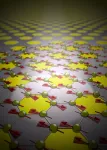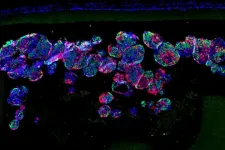Oldest human traces from the southern Tibetan Plateau in a new light
2021-06-02
(Press-News.org) Stone tools have been made by humans and their ancestors for millions of years. For archaeologists these rocky remnants - lithic artefacts and flakes - are of key importance. Because of their high preservation potential they are among the most common findings in archaeological excavations. Worldwide, numerical dating of these lithic artefacts, especially when they occur as surface findings, remains a major challenge. Usually, stone tools cannot be dated directly, but only when they are embedded in sediment layers together with, for example, organic material. The age of such organic material can be constrained via the radiocarbon technique. If such datable organic remains are missing or if stone artefacts lack a stratified sedimentary context, but rather occur as scattered surface artefacts, numerical dating becomes very difficult or is simply impossible. "The earth's surface is highly dynamic and erosion and redeposition of material, especially over long timescales, is common. A precise age determination of lithic artefacts that occur as surface finds has therefore hardly been possible so far. Many aspects of ancient human behaviour have only been preserved as surface finds, hence cannot be dated precisely with currently available dating methods. By further developing the Optically Stimulated Luminescence (OSL) dating technique, we can now, for the first time, carry out precise, and direct age measurements on lithic artefacts. In our current study we used stone artefacts from an archaeological surface site in south-central Tibet", explains Michael Meyer, head of the Luminescence Laboratory at the Department of Geology at the University of Innsbruck and one of the main authors of the study now published in the renowned journal Science Advances. OSL dating is based on the measurement of light stored in natural minerals and is one of the most important absolute dating tools in archaeology and the earth sciences. "This dating method uses natural light signals that accumulate over time in natural dosimeters, such as quartz and feldspar grains that are important constituents of sediments, as well as rocks and lithic artefacts. These minerals can be imagined as miniaturized clocks. Each grain is a tiny clock that can be 'read-out' under controlled laboratory conditions. The light signal allows us to infer the age of the archaeological sediment layer or artefact. The more light, the older the sample," says the geologist. "In this study, we have now taken a new approach and focused not on sediment grains of sand, but - for the first time - on stone artefacts themselves."
Quarrying activities more than 5,000 years ago
Due to its extreme environmental and climatic conditions the dry highlands of Tibet are considered to be one of the last regions on earth that were occupied by humans. When exactly peopling of this remote and rather extreme environments occurred has caused a lot of scientific debate over the course of the last decade. In 2017, Michael Meyer dated the famous human foot and hand prints of Chusang in the central part of the Tibetan plateau to an age between 8,000 and 12,000 years. In the current study, Meyer and his team analysed archaeological finds from southern Tibet in the Innsbruck OSL Laboratory: The excavation site Su-re is located immediately north of the Mount Everest-Cho Oyu massif in the so-called Tingri graben at an elevation of 4450 metres. Surface artefacts are particularly common in Tibet. To date them, the researcher used the so-called "Rock Surface Burial Dating" technique and applied it to lithic surface artefacts. This method determines the point in time when the stone artefact was discarded by humans and at least partly covered by earth. "With our luminescence method, we can look inside the stone and create a continuous age-depth profile. The inside of a rock has never been exposed to sunlight, so we have a saturated luminescence signal there and an infinite high age. However, if the rock surface is exposed to daylight for a long enough time, the signal in the top millimeters or centimeters of the rock will be erased. This happens during knapping, when the stone tool is produced, and also during the subsequent artefact use by humans. When the artefact is then discarded and at least partially buried in sediment and shielded from light, the luminescence signal in this artefact surface recharges. By measuring this depth-dependent luminescence signal in the rock surfaces, we can calculate the age of the artefact discard, taking into account the dynamics of local earth surface processes. Such an approach allows us to date stone artefacts directly, even if they occur as surface finds," Meyer explains. The analyses on the surface artefacts from southern Tibet revealed an age between 5,200 and 5,500 years. "We assume that the artefact findings at Su-re are related to quarrying activities at this site". Very old sites have been discovered in the central part of the Plateau, however, for southern sector of the Tibetan Plateau, Su-re is currently to oldest securely dated site.
For Michael Meyer, the analysis of these Tibetan artefacts is just the beginning: "This OSL-based method opens up new vistas in archaeological dating and holds great potential also for sites on other continents that preserve lithic artefacts in a favorable setting," concludes the geologist.
INFORMATION:
Publication:
L.A. Gliganic, M.C. Meyer, J.-H. May, M.S. Aldenderfer, P. Tropper: Direct dating of lithic surface artifacts using luminescence. Sci. Adv. 7, eabb3424 (2021). DOI: 10.1126/sciadv.abb3424
Links:
OSL Laboratory at the Department of Geology, University of Innsbruck, Austria: https://quaternary.uibk.ac.at/Research/Current-Research/Luminescence-geochronology.aspx
[Attachments] See images for this press release:

ELSE PRESS RELEASES FROM THIS DATE:
2021-06-02
Tested on human blood in the lab, the selective nanocapsules could reduce the side effects of a major blood clot dissolving drug, which include bleeding on the brain. If confirmed with animal tests, the nanocapsules could also make the drug more effective at lower doses.
Blood clots, also known as thrombi, are a key cause of strokes and heart attacks which are leading causes of death and ill-health worldwide. They can be treated with a clot dissolving drug called tissue plasminogen activator (tPA) which disrupts clots to clear the blocked blood vessel and re-establish blood ...
2021-06-02
Known as nature's own sonar system, echolocation occurs when an animal emits a sound that bounces off objects in the environment, returning echoes that provide information about the surrounding space.
While echolocation is well known in whale or bat species, previous research has also indicated that some blind people may use click-based echolocation to judge spaces and improve their navigation skills.
Equipped with this knowledge, a team of researchers, led by Dr Lore Thaler, of Durham University, UK, delved into the factors that determine how people learn this skill.
Over the course of a 10-week training programme, the team investigated how blindness and age affect learning ...
2021-06-02
Atomically thin van der Waals magnets are widely seen as the ultimately compact media for future magnetic data storage and fast data processing. Controlling the magnetic state of these materials in real-time, however, has proven difficult. But now, an international team of researchers led by Delft University of Technology (TU Delft) has managed to use light in order to change the anisotropy of a van der Waals antiferromagnet on demand, paving the way to new, extremely efficient means of data storage.
The thin atomic layers that make up van der Waals magnets may seem extremely fragile, but they can be about 200 times stronger ...
2021-06-02
In a six-month study of more than 1,000 Americans, R. Kelly Garrett and Robert Bond found that U.S. conservatives were less able to distinguish truth from falsehoods in 20 viral political news stories that appeared online between January and July 2019. Differences in the political orientation of these stories may help explain this observation, the researchers note, writing that "we find that high-profile true political claims tend to promote issues and candidates favored by liberals, while falsehoods tend to be better for conservatives." Two-thirds (65%) of the high-profile true stories were characterized as benefiting the political left, compared with only 10% that were described as benefiting the political right. Among high-profile false stories, 45.8% were perceived to benefit the ...
2021-06-02
Individuals at higher risk of developing pancreatic cancer could be identified earlier using machine learning (ML) techniques which would result in a greater number of patients surviving the disease, suggests a new study published in PLOS ONE.
The study was led by the London School of Hygiene & Tropical Medicine (LSHTM) and funded by the UK charity Pancreatic Cancer Research Fund (PCRF).
It used UK electronic health records for more than 1,000 patients aged 15-99 years who were diagnosed with pancreatic cancer between January 2005 and June 2009.
The researchers examined numerous symptoms and ...
2021-06-02
A team of researchers led by diabetes specialists and biomedical engineers at Washington University School of Medicine in St. Louis and Cornell University has demonstrated that, using a miniscule device, they can implant insulin-secreting cells into diabetic mice. Once implanted, the cells secrete insulin in response to blood sugar, reversing diabetes without requiring drugs to suppress the immune system.
The findings are published June 2 in the journal Science Translational Medicine.
"We can take a person's skin or fat cells, make them into stem cells and then grow those stem cells into insulin-secreting cells," said Jeffrey R. Millman, PhD, an associate professor of medicine at Washington ...
2021-06-02
A new study reveals that B cells can produce antibodies against the H1N1 influenza virus that also neutralize various other influenza strains, marking a development that could inform research into potential universal flu vaccines. The findings showed that the antibodies targeted two conserved regions of the virus - the cause of the 2009 swine flu pandemic - and that transfers of the antibodies protected mice from lethal infection. The work suggests that vaccines that target the two sites might be able to protect against a broader array of flu strains. Influenza is one of humanity's greatest microbial ...
2021-06-02
RICHLAND, Wash.--Scientists have created a cybersecurity technology called Shadow Figment that is designed to lure hackers into an artificial world, then stop them from doing damage by feeding them illusory tidbits of success.
The aim is to sequester bad actors by captivating them with an attractive--but imaginary--world.
The technology is aimed at protecting physical targets--infrastructure such as buildings, the electric grid, water and sewage systems, and even pipelines. The technology was developed by scientists at the U.S. Department of Energy's Pacific Northwest National Laboratory.
The starting point for Shadow Figment is an oft-deployed technology called a honeypot--something attractive to lure an attacker, perhaps a desirable target with the appearance of easy access.
But ...
2021-06-02
A new study from North Carolina State University found that certain types of messages could influence how people perceive information about the spread of diseases from wildlife to humans.
The researchers say the findings, published in the journal Frontiers in Communication, could help scientists, policymakers and others more effectively communicate with diverse audiences about zoonotic diseases and the role of wildlife management in preventing them from spreading to people. Zoonotic diseases are diseases that originate in wildlife and become infectious to people.
"If we want to prevent ...
2021-06-02
A new global review has found that receiving Opioid Agonist Therapy (OAT) is associated with lower risk of multiple causes of death among people with opioid dependence.
The review found that people with opioid dependence were less likely to experience overdose-related, suicide, alcohol-related, cancer, and cardiovascular-related mortality while receiving OAT.
Researchers from the National Drug and Alcohol Research Centre (NDARC) at UNSW Sydney, University of Bristol and several other global institutions reviewed the relationship between OAT and mortality across type of drug, setting and participant groups from over 700,000 participants, which is six times the number of any other previous review.
The review found that mortality risk ...
LAST 30 PRESS RELEASES:
[Press-News.org] Oldest human traces from the southern Tibetan Plateau in a new light


